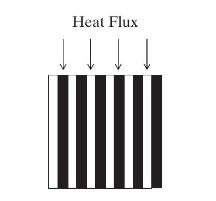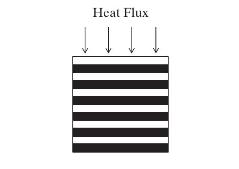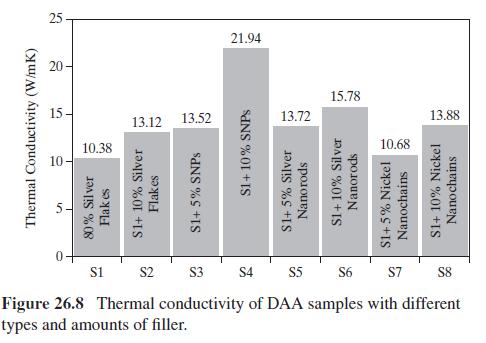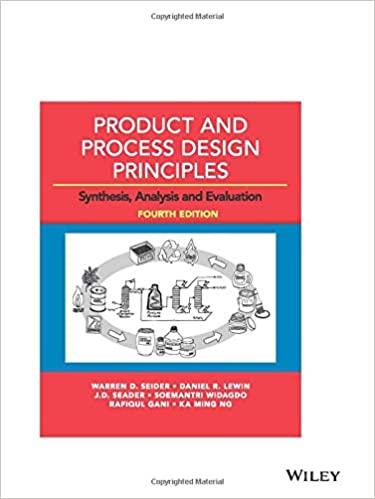Many models of a composite's effective thermal conductivity are available in the literature (Wang and Pan, 2008).
Question:
Many models of a composite's effective thermal conductivity are available in the literature (Wang and Pan, 2008). Even if a model cannot accurately predict the DAA product performance, physical insights that are beneficial to product development can be obtained from a simplified model.
(a) For a parallel model, consider a two-component composite consisting of strips of epoxy (light) and silver (dark) aligned in the same direction as the heat flow. The volume fraction of silver in the composite is \(\phi\).

Prove that the effective thermal conductivity of the composite \(k_{\text {eff }}\) is \[k_{e f f}=(1-\phi) k_{e}+\phi k_{s}\]
where the conductivities of epoxy and silver are \(k_{e}=5 \mathrm{Wm}^{-1} \mathrm{~K}^{-1}\) and \(k_{s}=420 \mathrm{Wm}^{1} \mathrm{~K}^{-1}\), respectively. Calculate and plot the dependency of \(k_{e f f}\) on \(\phi\) in the range of \(0.2
(b) For a series model, the microstructure is in the form of strips of epoxy and silver aligned perpendicular to the direction of heat flow.

Prove that the effective thermal conductivity of the two-component composite is \[k_{e f f}=\left(\frac{1-\phi}{k_{e}}+\frac{\phi}{k_{s}}\right)^{-1}\]
Calculate and plot the dependency of \(k_{e f f}\) on \(\phi\) in the range of \(0.2
(c) A mixture of parallel and series configurations is expected for the DAA product. A model was proposed for such a microstructure (Agari et al., 1986):
\[k_{e f f}^{n}=(1-\phi)\left(C_{e} k\right)_{e}{ }^{n}+\phi k_{s}^{C_{s} \cdot n}\]
Here, \(C_{e}\) is an adjustable parameter for the epoxy phase \(C_{s} \in(0,1]\); it represents the degree of difficulty in forming a conductive silver path in the DAA. In the limit of \(C_{s} \rightarrow 0\), the impact of \(k_{s}\) on \(k_{e f f}\) is greatly minimized. The parameter \(n \in[-1,1]\). The parallel model and the series model are recovered when \(n\) equals 1 and -1 , respectively. For the DAA having a microstructure between the parallel and series models, \(n \approx 0\), prove that in the limit of \(n \rightarrow 0\)
\[\log k_{e f f}=\phi\left[C_{s} \log k_{s}-\log \left(C_{e} k_{e}\right)\right]+\log \left(C_{e} k_{e}\right)\]
(d) Figure 26.8 shows the thermal conductivities of different DAA prototypes. Sample S1 is a mixture of silver flakes ( \(80 \mathrm{wt} \%\) ) and epoxy (20wt\%).
(1) Determine \(C_{\mathrm{e}}\) and \(C_{\mathrm{s}}\) from \(\mathrm{S} 1\) and \(\mathrm{S} 2\) by data fitting.
(2) Assuming \(C_{\mathrm{e}}\) is a constant, calculate \(C_{\mathrm{s}}\) from \(\mathrm{S} 1\) and \(\mathrm{S} 3\).
(3) Using \(C_{\mathrm{e}}\) and \(C_{\mathrm{s}}\) from (2) calculate \(k_{e f f}\) of S4. Compare the calculated value with the experimental value and explain what may cause the difference, if any.
Figure 26.8:-

Step by Step Answer:

Product And Process Design Principles Synthesis Analysis And Evaluation
ISBN: 9781119355243
4th Edition
Authors: Warren D. Seider, Daniel R. Lewin, J. D. Seader, Soemantri Widagdo, Rafiqul Gani, Ka Ming Ng




